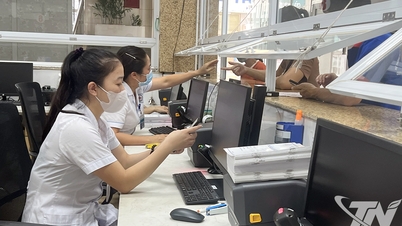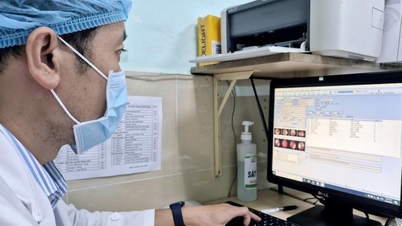Currently, the implementation of electronic medical records is being carried out in hospitals. According to the previously announced digital healthcare transformation roadmap, by September 30, 2025, all hospitals will have to complete the implementation of electronic medical records to replace paper medical records from October 2025.
This is a mandatory requirement of the Government and the Ministry of Health to modernize the medical examination and treatment system, synchronize data, and better serve the people.
Optimize processes
Going to the Vietnam-Cuba Friendship Hospital for a check-up, Ms. Nguyen Thanh M. (75 years old, in Cua Nam ward) said that recently she has heard a lot of information about hospitals implementing electronic medical records. She was excited when she went for a check-up and only needed to bring her medical records without having to bring the results of previous examinations, because the doctor had saved the results information on the patient's medical examination and treatment software.
Mr. Nguyen Dinh V. (72 years old) is being examined at the Hanoi Oncology Hospital and said that the examination procedure is faster than before, the results of X-rays and blood tests are sent directly to the initial examination room, he no longer has to run to other locations to get the results. After that, the doctors save the results, each time he goes for a check-up, he only needs to bring the medical examination book, which is very convenient.

Duc Giang General Hospital officially qualified to deploy electronic medical records from October 1. Associate Professor Do Dinh Tung - Director of Duc Giang General Hospital said that deploying electronic medical records at the hospital is a key part of the digital transformation process, bringing benefits to both the hospital and patients. For the hospital, the biggest benefit is process optimization. Instead of spending time searching and storing paper records, medical staff can immediately access medical records on the management software (HIS), helping the medical examination and treatment process to be smooth and quick.
In addition, electronic medical records help apply artificial intelligence (AI) in the system to warn of drug interactions, supporting doctors to prescribe more safely and effectively. Next, the hospital also saves long-term costs: Reduces costs of printing, preserving, and storing paper records; Reduces errors due to manual recording, avoids errors in drug dosage, drug allergies...
Associate Professor Do Dinh Tung emphasized that for patients, the biggest benefit is that they no longer have to carry many types of records and documents each time they return for a check-up. All information has been stored electronically, medical examination and treatment procedures are faster, reducing waiting time to 30-60 minutes. Second is proactive information, patients can look up and update their medical records quickly through support applications; Help patients better understand their health status
In addition, electronic medical records also allow data to be shared between medical facilities, helping patients avoid having to repeat existing tests. Finally, it also increases transparency in health insurance management, reducing complicated administrative procedures.
630 medical facilities have used electronic medical records.
Professor Le Van Quang - Director of K Hospital said that the hospital currently has 2,400 beds and 1,910 medical staff serving. In 2024, the hospital will receive 436,208 medical examinations, 68,119 inpatients, 31,683 surgeries and 262,607 MRI and CT scans, 4,488 other cases in specialized technical categories. The implementation of electronic medical records to replace paper medical records brings many benefits to patients and medical staff, contributing to cost savings, improving productivity and quality of medical examination and treatment.

Information management has also become more efficient. All patient records are stored synchronously, making it easy for doctors to access and track medical history, thereby making more accurate diagnoses. This system also helps reduce costs by eliminating the need to print records, papers and films.
Minister of Health Dao Hong Lan said that according to the original plan, the implementation of electronic medical records will be carried out in 2025. The Prime Minister also requested the implementation of electronic medical records nationwide before September 30, 2025.
To date, 630 medical facilities nationwide have used electronic medical records, not paper medical records; 84/125 grade 1 provincial public hospitals have implemented this, accounting for about 70%.
On the side of the Ministry of National Defense, 31 hospitals under the Ministry have completed the implementation of electronic medical records 100%. For the Ministry of Public Security, 66% of hospitals have completed it, the remaining facilities are trying to complete it on schedule.
Regarding private hospitals, Minister Dao Hong Lan said that 140/399 hospitals have implemented electronic medical records and the remaining facilities are speeding up the progress and are determined to implement./.
Source: https://www.vietnamplus.vn/benh-an-dien-tu-benh-vien-bac-sy-va-nguoi-benh-deu-huong-tien-ich-post1067818.vnp


![[Photo] Solemn opening of the 8th Congress of the Central Public Security Party Committee, term 2025-2030](https://vphoto.vietnam.vn/thumb/1200x675/vietnam/resource/IMAGE/2025/10/4/f3b00fb779f44979809441a4dac5c7df)

![[Photo] General Secretary To Lam attends the 8th Congress of the Central Public Security Party Committee](https://vphoto.vietnam.vn/thumb/1200x675/vietnam/resource/IMAGE/2025/10/4/79fadf490f674dc483794f2d955f6045)
![[Photo] Bustling Mid-Autumn Festival at the Museum of Ethnology](https://vphoto.vietnam.vn/thumb/1200x675/vietnam/resource/IMAGE/2025/10/4/da8d5927734d4ca58e3eced14bc435a3)
































![[Infographic] Notable numbers after 3 months of "reorganizing the country"](https://vphoto.vietnam.vn/thumb/1200x675/vietnam/resource/IMAGE/2025/10/4/ce8bb72c722348e09e942d04f0dd9729)




























![[VIDEO] GENERAL SECRETARY TO LAM AWARDS PETROVIETNAM 8 GOLDEN WORDS: "PIONEER - EXCELLENT - SUSTAINABLE - GLOBAL"](https://vphoto.vietnam.vn/thumb/402x226/vietnam/resource/IMAGE/2025/7/23/c2fdb48863e846cfa9fb8e6ea9cf44e7)
































Comment (0)